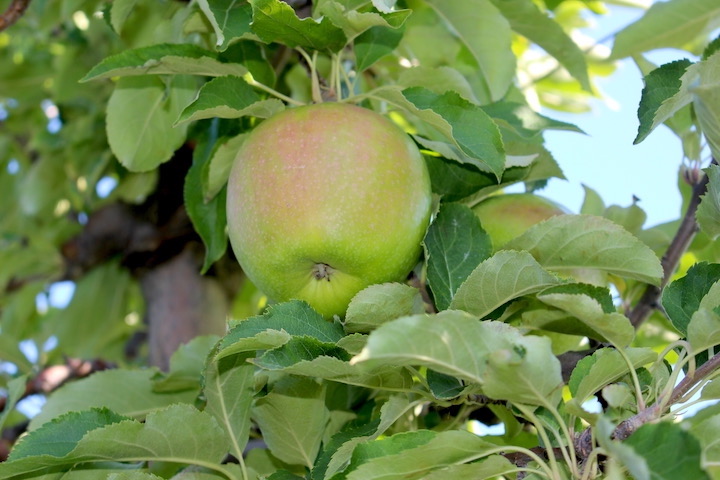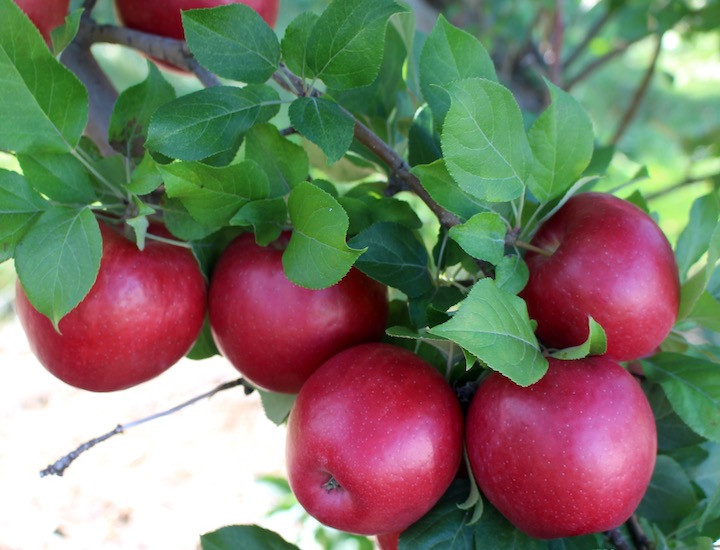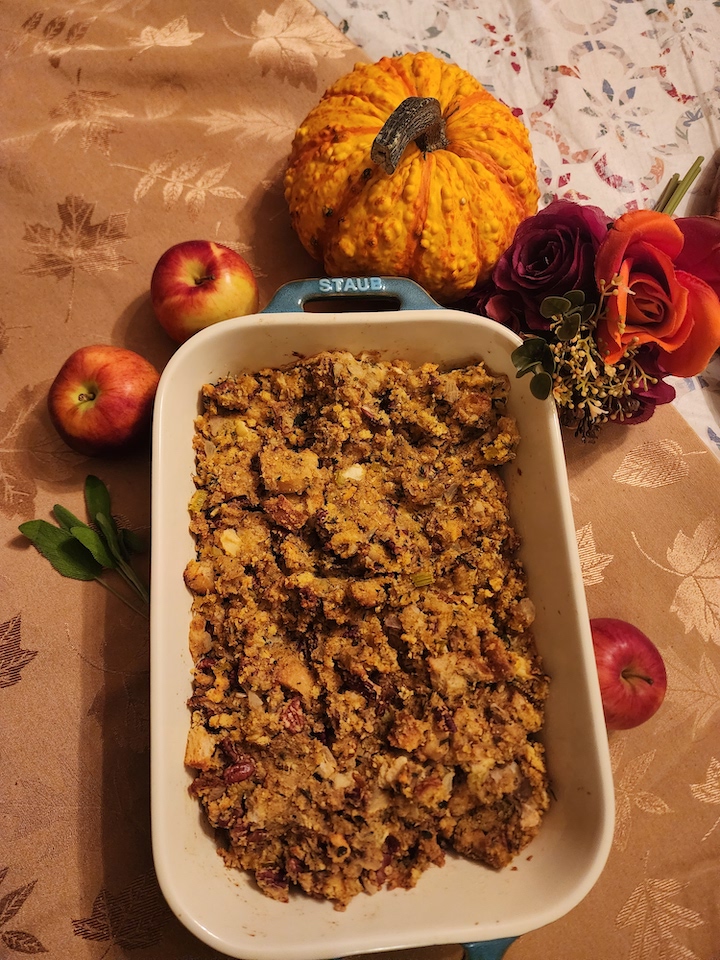ADRIENNE ANIFANT
WHEN I WAS A CHILD, I would wait all year for Thanksgiving so I could indulge in my mother’s stuffing made from scratch. She would make one with sausage and cranberries and another that was plain for my sister and me. Drowned in homemade gravy and mixed with creamy mashed potatoes, it was worth the wait.
As I flip through cookbooks and plan my own Thanksgiving menu, I search for recipes that hopefully my children will remember fondly when they are grown.
A lifelong East Coaster, I never ate cornbread stuffing before, but my college friend from the South said that it was a perfect harmony of flavors and textures. And who doesn’t love biting into a piece of sweet, nutty cornbread? The crispy crust collapses into a moist, pillowy dream.
Cornbread is one of our oldest foods. Native Americans, Aztecs, and Mayans learned to roast corn and grind it into a thick meal to make cakes, bread, tortillas, and porridge 7,000 years ago.
Corn, beans, and squash were considered a sacred trinity in the Iroquois and Cherokee traditions. They called them the Three Sisters because, when they are planted together, they support and nurture each other like family.
Beans produce valuable nitrates that fertilize the soil for the squash and beans. Tall corn stalks support the vines of the beans that grow and wind around them. Squash’s large leaves provide shade that prevents weeds from overtaking the plants while helping to retain moisture in the soil.
Their shared spirits were called the De-o-ha-ko which means “our sustainers” or “those who support us.”
* * *

THIS THANKSGIVING, I am making Apple Cornbread Stuffing in honor of De-o-ha-ko and the unlimited ways we can be like the Three Sisters, nurturing each other and our Earth. Like family.
In this recipe, the sweet-tartness and texture of the apples adds a fresh, unexpected flavor that is a perfect complement to the rich cornbread and the classic, savory herbs of parsley, sage, and thyme.
I chose Honeycrisp and Granny Smith apples because I love the juxtaposition of the sweet Honeycrisp and the tart Granny Smith, and they both maintain their firmness when cooked.
Granny Smith apples have not been widely cultivated in New England in the past because they require a long growing season. But with milder weather, more and more New England orchards are planting them (see a list of orchards that grow Granny Smith when you click on the apple’s name).
The apple’s origins are intriguing: originating in Sydney, Australia, in 1868 by Maria Ann “Granny” Smith.
After emigrating from England, she and her husband bought a small orchard. One day, while cooking with French crabapples, she threw out the scraps in a compost pile near a stream behind her house. A new apple tree grew from the compost pile that produced a truly original apple.

Honeycrisp is widely known and loved around the world since its development at the University of Minnesota by the Minnesota Ag Experiment Station’s Horticultural Research Center in 1961. Characterized by an explosive crunch, juiciness, and vibrant sweetness, Honeycrisp is now in the top five most produced apples in America, comprising about 13.7 percent of domestic apple production.
New England-grown Honeycrisp typically offer outstanding color as well as their distinctive texture and flavor. Honeycrisp are notoriously challenging to grow, but places like Cooper Farms, West Paris, Maine, one of the earliest orchards to specialize in them, now produce some of the finest Honeycrisp in the nation.
Visit an orchard near you or your supermarket to buy a bag of fresh, locally grown Honeycrisp!
* * *
FOR THE STUFFING, I made my own cornbread, but there are cornbread mixes available in the store that are very good. For guests with gluten allergies, you can substitute all-purpose with gluten-free flour.
Apple Cornbread Stuffing
Adapted from recipe bloggers Erin Clarke at wellplated.com and Katie Webster at healthyseasonalrecipes.com
Stuffing
3 T butter
1 T extra-virgin olive oil
1 medium yellow onion, finely chopped
3-4 cloves garlic, minced
4 celery stalks, diced
3 New England apples, peeled and diced in ½-inch pieces (I used 2 Honeycrisp and 1 Granny Smith)
¼ c finely chopped flat-leaf parsley
2 T freshly chopped sage or 2 t rubbed sage
1 T fresh thyme leaves or 1 t dried thyme
1 t salt
1/2 t ground black pepper
1/8 t cinnamon
¼ c hard or fresh apple cider
2 ½ c chicken or vegetable broth
2 large eggs
8 c cornbread (or 4 c white bread, French baguette, sourdough, or whole wheat; plus 4 c cornbread)
¾ c toasted chopped pecans
Preheat oven to 350⁰F. Grease 9″ x 13″ pan.
Melt butter and oil in a large skillet over medium heat. Add onion, garlic, and celery and cook until onion is translucent and vegetables are softened, 3 to 4 minutes. Stir occasionally.
Add apples, parsley, sage, thyme, salt, pepper, cinnamon. Cook, stirring until herbs are fragrant, 1 to 2 minutes.
Add cider and stir to combine. Simmer until evaporated, 2 to 3 minutes. Add broth and bring to a simmer.
Whisk eggs in a large bowl. Temper eggs by whisking about 1 c cider-and-broth liquid into them. Add eggs to remaining vegetable and broth mixture, stirring constantly.
Add cornbread and pecans and toss to combine. Transfer to prepared baking dish and cover with foil.
Bake until stuffing is heated through, 25 to 30 minutes. Remove foil and continue baking until top is lightly browned, 10 to 15 minutes.
Cornbread
1 c milk, room temperature
1 T white vinegar or lemon juice
¼ c honey
2 eggs
6 T unsalted butter, melted and cooled to room temperature
1 c yellow cornmeal (medium grind)
1 c all-purpose flour
2 t baking powder
1/2 t baking soda
½ t salt
Preheat oven to 425⁰F. Grease 8″ x 8″ baking pan.
In medium bowl, stir together milk and vinegar. Set aside for 5 to 10 minutes. Stir in honey, eggs, and melted butter.
In large mixing bowl, whisk together cornmeal, flour, baking powder, baking soda, and salt. Add wet ingredients, folding gently to combine.
Pour the batter into the prepared pan. Bake for 16 to 20 minutes, until the cornbread is a light golden brown and an inserted knife or toothpick comes out clean. Set aside to cool.
Reduce oven to 300⁰F. Cut cornbread into 1-inch cubes. Spread cubes in a single layer on an ungreased or parchment-lined baking sheet. Toast for 15 minutes.
